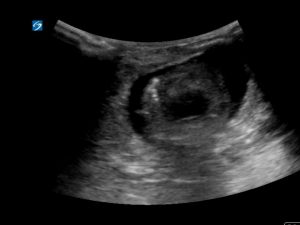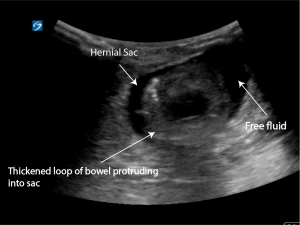
Images and text by Genevieve Carbonatto
A 54 year old presents with an umbilical hernia. He says that he has always been able to push it back, but not this time.
This is his ultrasound scan
Note the umbilical hernial sac. The loop of bowel is not moving within the hernia. The bowel is surrounded by peritoneal fluid.


There is a suggestion of bowel contents moving in the bowel but there is no peristalsis of the bowel. This is an incarcerated hernia
Discussion (1)
A hernia consists of 3 parts
- The sac which is a diverticulum of the peritoneum
- The covering which are derived from the layers of the abdominal wall through which the sac extends
- The contents which are usually fat (hypoechoic) or bowel
Types of hernias:
- Reducible – A simple hernia can be pushed back through the defect using palation or probe pressure
- Incarcerated – The hernia is nonreducible and contains viable content
- Strangulated -The hernia is nonreducible and contains viable contents vascularly impaired and may become necrotic and perforate
Reference
- Clinical ultrasound : Paul Allan, Grant Baxter, Michael Weston





